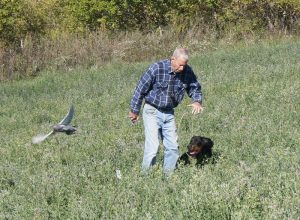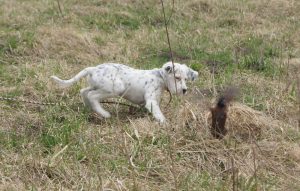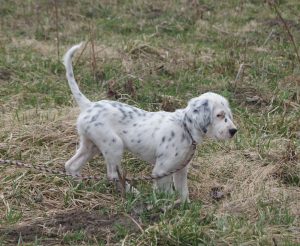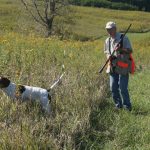Puppy Primer: Puppies and Birds
Pointing Dog Pointer
by Bob and Jody Iler
The first in our short series of Puppy Primers focuses on why you got your pointing dog pup to begin with: to find and point birds! There’s plenty of information out there on what to do with your pup in the first few months, but in this column we’re going to talk specifically about your puppy and birds. Here are some common questions that new pointing dog owners may have:
What age should my pup make her first acquaintance with birds (other than yard birds)?
There’s no right or wrong age for puppies to “meet the birds!” What’s more important is how you make the introduction and how you read your pup’s temperament and reaction. Because we have birds, we generally introduce our own pups to them at eight to twelve weeks of age.
We always use hobbled quail first; they are small, they are game birds, and puppies love them. Once they “meet” the hobbled quail, they get excited. They nuzzle it, they may pick it up, they may bark at it. Because it can’t run or fly, they are emboldened, and ready to meet the next quail on the path, which is “dead planted” but not hobbled, and easy for pups to find. They find this one and as it “awakes” it may run or fly, and they give chase. Now they can identify what quail scent is the next time they go to the field.
It’s important to make these first encounters with birds fun and easy. Using pigeons or larger birds can often scare young pups and cause problems you don’t want! If you don’t have access to birds, don’t worry! We don’t start our clients’ pups until about six months of age. We’ve also had older dogs come in to the kennel, sometimes two or three years of age, that have had no experience with birds. Depending on their temperaments and reactions, we follow a similar program of positive introduction to birds. Many of these dogs, if they come from the right bloodlines, develop into good pointing dogs as well.
Should I let my young pup run with the “big dogs” on birds?
Letting your pup run with the “big dogs,” learning from them, may seem like a good idea in theory, but with pointing dogs, can often result in big problems. Young pups aren’t ready to be started on pheasants and hunt in tough cover. If they have a bad experience in the field they can be turned off of birds for a good long while. We have gotten dogs in for training, or rather, to hopefully “be re-trained” to like birds after these bad experiences, and we can attest that sometimes it can take a great deal of time and going back to the basics to get the pup going again. It’s also not fair to the “big dogs” to have young dogs rushing in on them while they are on point. To sum it up, work only pointing dogs that have had the same level of bird exposure and training together; start your young pup out on his own and help him to experience and learn for himself.
Will my pup automatically be a good bird dog, just because he’s a pointing dog breed?
This question is one to which we’d have to answer, “Not always.” Over the years we’ve had pups come in to the kennel with varying degrees of birdiness. Some of these pups are slow to start and later come on strong; many develop to a satisfactory level of enthusiasm for hunting, finding, and pointing birds; and an unfortunate few just don’t cut it.
Years back, we had one young bird dog that lifted his leg nonchalantly on the bird—not a good sign! Another nice young pointing dog pup, Kai, out of dual bloodlines, breezed through two months of our started dog program with a “take them or leave them” attitude when it came to birds. He ran happily through the field and woods and depending on his mood, he flash pointed, half-heartedly chased, or—more likely—ignored the birds. He just wasn’t all that interested despite our best efforts. Kai became a well-loved couch potato whose owners got another pointing dog of the same breed but different bloodlines. We trained this new dog, no charge, for his owners, and she went on to earn field titles.
Did we do anything different? No! The dogs were different; and genetics are key. A word of caution here to note: sometimes pups will take longer to develop, so give them a chance and don’t give up. Kai belonged to a client and we didn’t want to waste their money, but if he had been our own dog, we’d have given him a good year or so to see what happened. We did advise them on what to try as he got older, but Kai had other aspirations and remained a house pet!
If my pup doesn’t like pigeons, is this cause to give up on him?
For many pointing dog owners, pigeons are often the only birds they can acquire to do a little bird work with their pups. As mentioned above, if pigeons are the first birds introduced to very young pups, the whir of their wings when flushed, and the fact that they will fly up and away quickly is often counterproductive to bird introduction. We want the young pups to be excited, not intimidated; to give chase, not stand and watch the bird fly away. If pigeons are all you have to use, we’d recommend hobbling the bird (both wings and feet) and letting the pup find it just as we do for quail first. If the pup is interested, you might next unhobble the legs and let the pigeon run a little and see if pup will chase. If so, the next step would be to unhobble the pigeon entirely, dizzy the bird, and “dead plant” it for pup to find. If the bird is dead planted, the pup will have time to find it while the bird is still disoriented and won’t readily flush. This whole scenario applies mainly to young pups; as they get older, obviously, we don’t want them catching the birds, but rather, pointing them for us to find and flush. But this column is not about pointing, it’s about puppies and birds.
What if your pup shows no interest in pigeons? Should you be worried that you don’t have a bird dog? Speaking from experience, most of our dogs that come in for training will work pigeons well, but sometimes without as much intensity as on game birds. Some dogs (and we owned one for 12 years) simply refuse to work pigeons and are only interested in game birds. It’s important to note that you won’t be hunting pigeons; they are just a means to the end of introducing birds and training your dog. And if your pup doesn’t like pigeons, don’t write him off! Get yourself some quail or hook up with a trainer who has quail and get your pup going on one of the game birds he was bred to find!
At some point during your pup’s first year, she should have proper introduction to birds, as well as training and development in hunting and finding them. Whether this is done at your local game preserve, bird dog club, with friends who raise or have birds, or with a professional trainer—one way or another, your pointing dog pup will need to “meet the birds.” It’s up to you to make that first acquaintance a positive one, setting the stage for the future!
Pointing Dog Pointers features monthly training tips by Bob and Jody Iler, who own Green Valley Kennels in Dubuque, Iowa. Bob and Jody have trained pointing dogs for over 35 years and have written many articles for Pointing Dog Journal. Visit our website at: http://greenvalleykennels.homestead.com/com.html.








